Tactical Analysis: Sassuolo’s Flexible Build-Up Strategies
- nigel133
- Sep 14, 2021
- 9 min read
For tacticians worldwide, Sassuolo and intriguing build-up dynamics have become synonymous in recent seasons after the eye-catching playing style implemented by Roberto De Zerbi. So far this season under the very promising young coach Alessio Dionisi, who guided Empoli to promotion last season, Sassuolo are again catching the eye thanks to their exciting playing style. It is definitely a case of new season, same old Sassuolo in regards to tactical intrigue.
This tactical analysis investigates the build-up tactics used by Dionisi away at AS Roma on Sunday. Even though Roma emerged victorious after Stephan El-Sharaawy’s superb strike in added time, Sassuolo thoroughly impressed with their ability to consistently play through Roma’s press to end up creating a bunch of excellent goal scoring opportunities.
This was largely down to the flexible nature of Sassuolo’s attacking structures, their commitment to verticality and their method for opening up attractive spaces to attack.
Initial structures
Sassuolo set up in a 4-2-3-1 and look to build from the back in the structure pictured below. Six players come deep to initiate build up while the four attackers stay higher in an attempt to pin the opposition defence, creating an overload around the ball to facilitate progression of the ball.
Just like De Zerbi before him, Dionisi has kept some of the initial structures when building from the back. For instance, the double pivot comes very deep to support the centre-backs and goalkeeper. They overload the initial Roma press and provide options to break that press. Additionally, they are positioned deep to attract pressure, opening up space behind them in the process. More on that later. Also note the positioning of the two full-backs. They are both quite deep, which I’ll discuss further below.
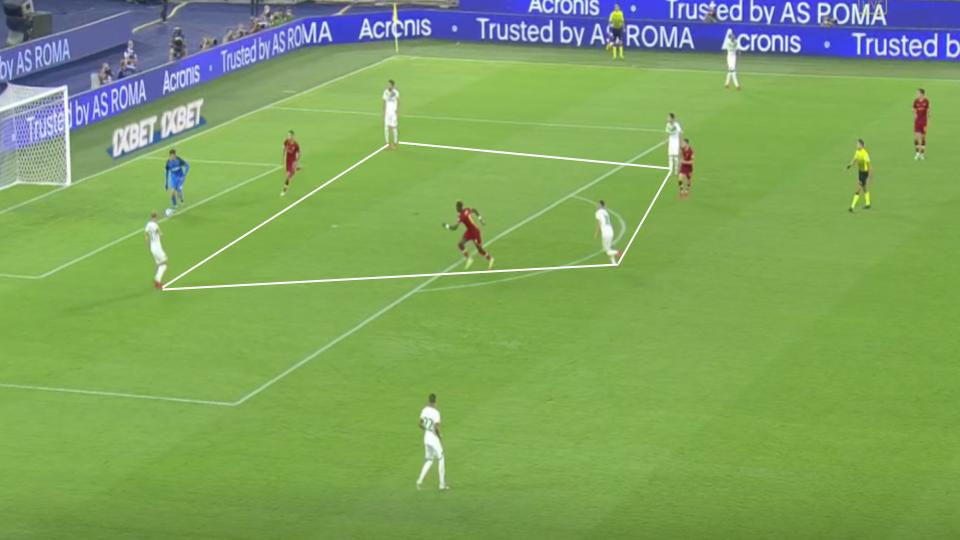
Sassuolo’s initial build-up structure with the goalkeeper between the two centre-backs, the double pivot deep and the full-backs deep.
The image below is another example of how Sassuolo look to attract players to press them. Ideally, the opponent will commit numbers to their press. This would open space behind the press for Sassuolo to exploit. As highlighted earlier, the four attackers stay high with the wingers wide and the striker Giacomo Raspadori central which allows Sassuolo to pin the opponent’s defensive line. As a result, the number ten Filip Đuričić can drop into the space vacated in midfield when the opponent press high. This creates a conundrum for the opposition as they could commit players to press Sassuolo high, but then space will probably be vacated between the lines of defence and midfield. If they don’t commit players to press, Sassuolo will comfortably progress the ball.
Back to the image below. The excellent Maxime Lopez would sometimes drop into the penalty area from goal kicks to help overload Roma’s initial press. What I want to focus on here is the positioning of the full-backs. Rogerio (yellow) is very deep. This is likely done to force Roma’s right-winger Nicolò Zaniolo to vacate central spaces when he presses. Since the distance is large between them, Zaniolo’s pressing movement will either open up space centrally (if he presses Rogerio) or allow Rogerio to receive with plenty of time on his hands (if Zaniolo stays central.
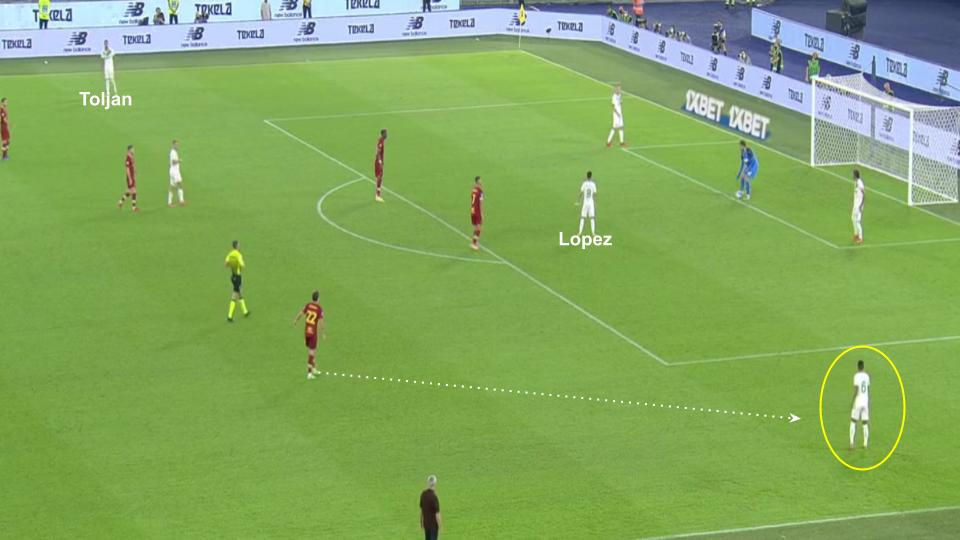
Here we can note the deep positioning of Sassuolo’s full-backs in an attempt to draw out Roma players to press them.
In the below image, we can see why the full-backs are deep. The ball has been moved to right-back Jeremy Toljan and he is instantly pressed by Roma’s left-winger Henrikh Mkhitaryan. In the process, the Armenian vacates space centrally. As the ball was travelling wide, Lopez took advantage of his blindside positioning behind Lorenzo Pellegrini to run into the empty space and make himself available for central progression. On this occasion, however, Toljan opted for a pass down the line, but the benefit is clear.
People sometimes ask what the point is of building play so deep when you’re so far away from goal, but Sassuolo are a good example of why this is an effective strategy. They have two of Europe’s best and most direct wide players in Domenico Berardi and Jeremy Boga so it makes sense that Sassuolo want to attract players to press them in an attempt to isolate their wide players with plenty of space to attack. Add the directness and trickery of Đuričić between the lines with Raspadori’s ability to run the channels as well as linking play and you have an attack that thrives when given large spaces to attack.
For Sassuolo, it is paramount to attract players to press them. The reason is simple: whenever someone steps out of line to press, they vacate space, as we saw with Mkhitaryan above. In the image below, we can see how Sassuolo take advantage of this. Ferrari is pressed by Pellegrini who blocks the pass to Lopez. Ferrari opts for Frattesi instead, and the young Italian immediately frees Lopez to progress the ball forward.

Sassuolo combining deep to play through Roma’s press.
This idea of attracting players to press can also be evident further up the pitch. As highlighted in the image, Frattesi attracts the attention of Veretout, which allows Đuričić to provide a vertical pass option behind Roma’s midfield. Again, note the deep position of at right-back in an attempt to draw Mkhitaryan out of position, increasing the space available to find Đuričić between the lines.
Sassuolo’s initial build-up structures are geared to one goal: attract opponents to open up space behind the press. Making use of their goalkeeper Andrea Consigli in build-up helps them create a constant numerical advantage and the pinning of four defenders with three attackers further helped them progress the ball smoothly against Roma.
Flexible positioning in build-up
Dionisi’s Sassuolo constantly manipulate the opponent by adopting flexible build-up positions to confuse the opponent and draw out pressers. In this way, they make it very difficult to prepare a way to press them. The following examples will illustrate this.
In the image below, the two full-backs are highlighted in yellow. The left-back Rogerio has moved high and central, positioned behind Roma’s midfield line while the right-back Toljan occupies a somewhat centred position on the right. The two wingers Boga and Berardi occupy width. The two central midfielders (red) also adapt their positioning as Lopez has dropped into the space vacated by Rogerio while Frattesi remains central. In doing so, Sassuolo establish a stable 2-3 structure when playing out from the back.
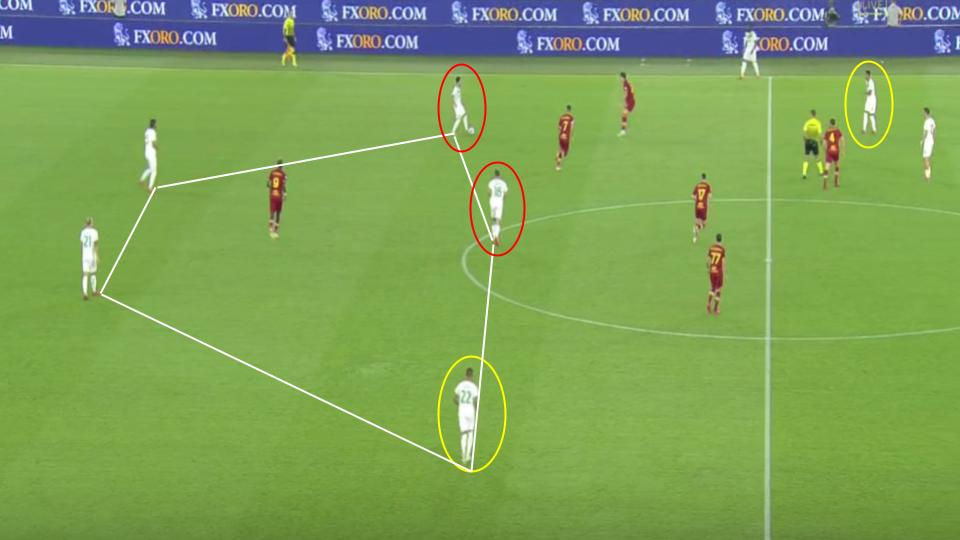
Sassuolo in a 2-3 structure with the centre-backs, Toljan and the two central midfielders.
The below image instead sees Rogerio push into a deeper midfield position with Toljan deep (but on the way to a narrow position again. Frattesi has pushed high in this scene and this sees Lopez and Rogerio form a situational double pivot.
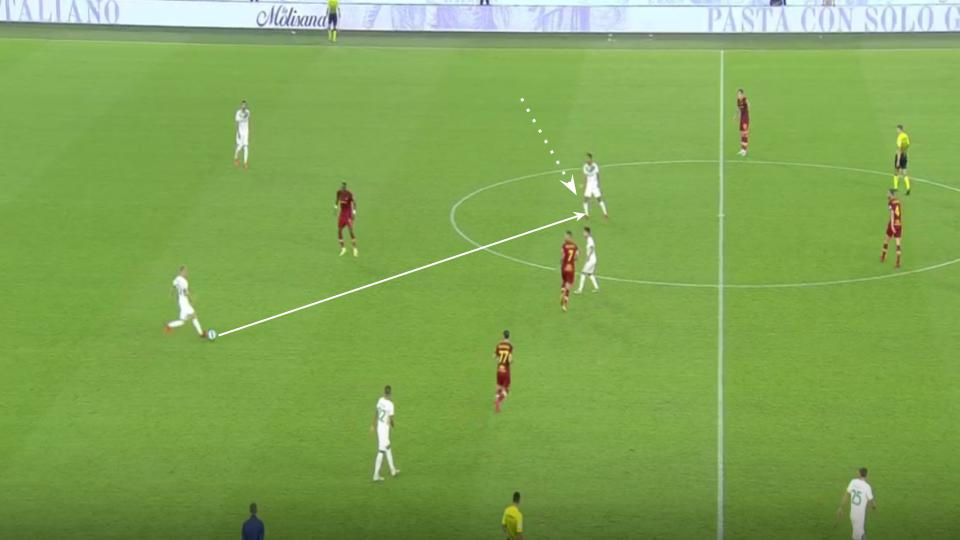
Here, Rogerio pushes into central midfield.
The image below highlights yet another structure as Roma are very narrow with their front six. Here, Lopez drops in between the centre-backs who split wider. Rogerio has again moved into the centre as Boga occupies the wide area. Frattesi has remained in the centre to attract Veretout in what surely is an attempt to free Đuričić behind Roma’s midfield. With Lopez having dropped and formed a back-three, Toljan moves wider than in previous situations.
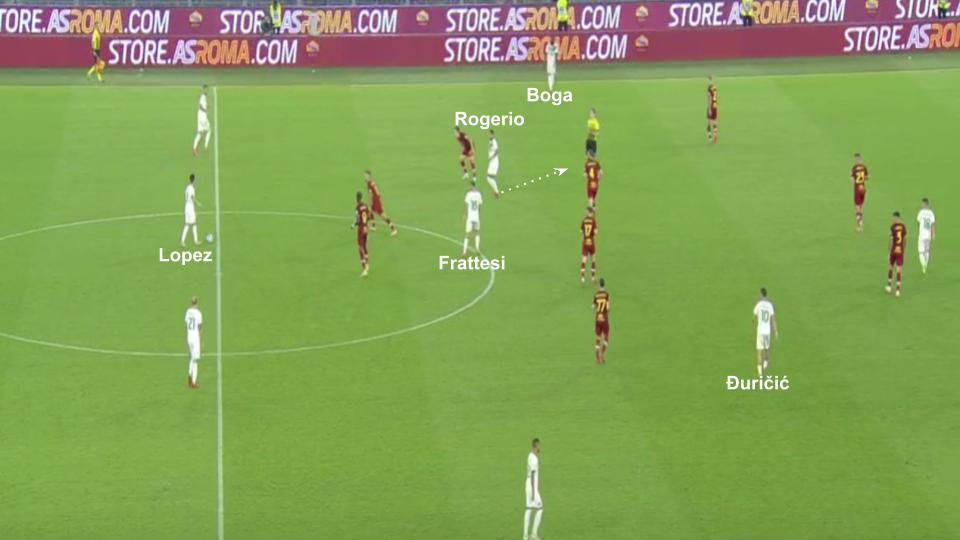
Lopez in between the centre-backs to overload Roma’s front two of Pellegrini and Abraham.
Similar to an earlier example, Lopez has again dropped wide in the image below which also sees Frattesi remain between Roma’s first and second line. We can also note that Toljan occupies a narrow position that is far enough away from Mkhitaryan to receive in space if given the ball but also close enough for the Armenian to potentially move wider, opening up space for the pass to Đuričić. What is different to the previously very similar scene is that Rogerio is now playing wide while Boga has moved into the centre.
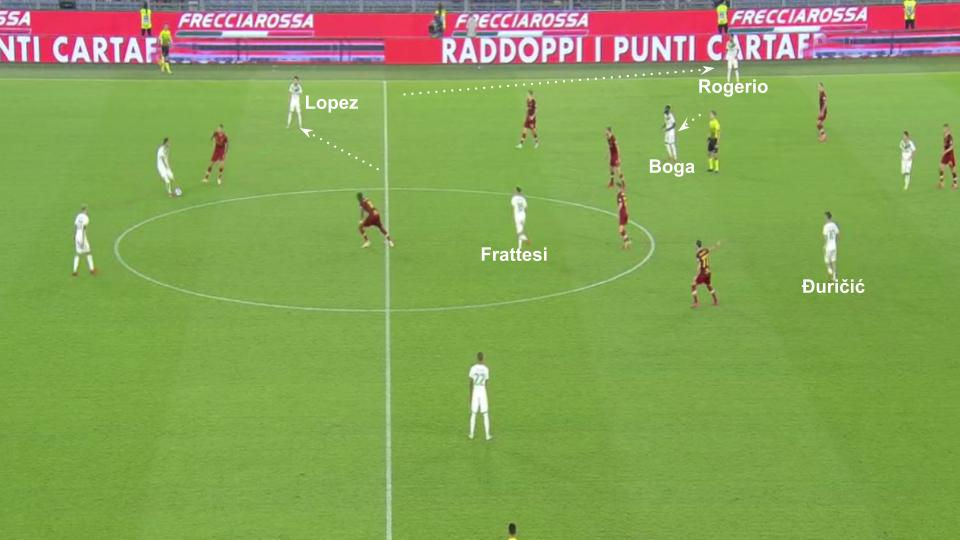
Different roles for Rogerio and Boga here than in the previous example.
Dionisi won promotion to the Serie A with Empoli last season and did so playing a very organised 4-3-1-2. We could see shades of this shape when Sassuolo looked to overload central areas at the Olimpico. Here, Boga (red) and Toljan provide the width Empoli’s full-backs did last year while Rogerio (yellow) and Frattesi flank a situational midfield diamond with Lopez at the base and Đuričić at the tip. This might be something we’ll see more of over the course of the season.
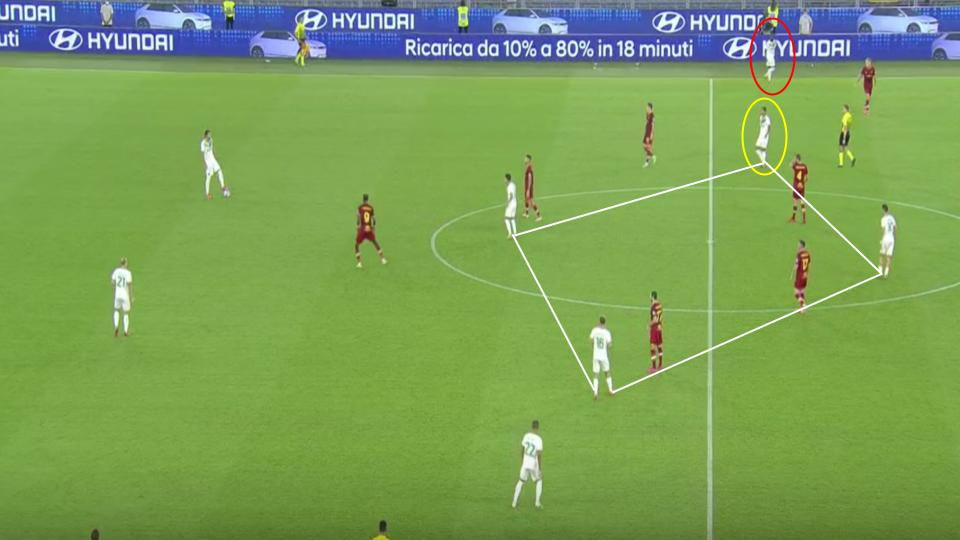
Sassuolo building in what is an assymetric 4-Diamond 2 (Berardi is still playing wide on the right with only Raspadori up front).
Sassuolo’s positioning was very flexible and interchangeable and it was impressive to see how seamlessly the players slotted into different areas of the pitch with ease. Their understanding of spaces and relationships in amongst each other will only improve as the season goes on.
Vertical focus
So, what are Sassuolo actually doing when they have the ball having moved into various attacking structures? More than anything, they want to play the ball forward. A lot. And quickly. So they do.
The image below highlights this. Many midfielders would opt to recycle possession by playing outside the Roma block to a defender, but Lopez breaks Roma’s first line by firing the ball into Frattesi.
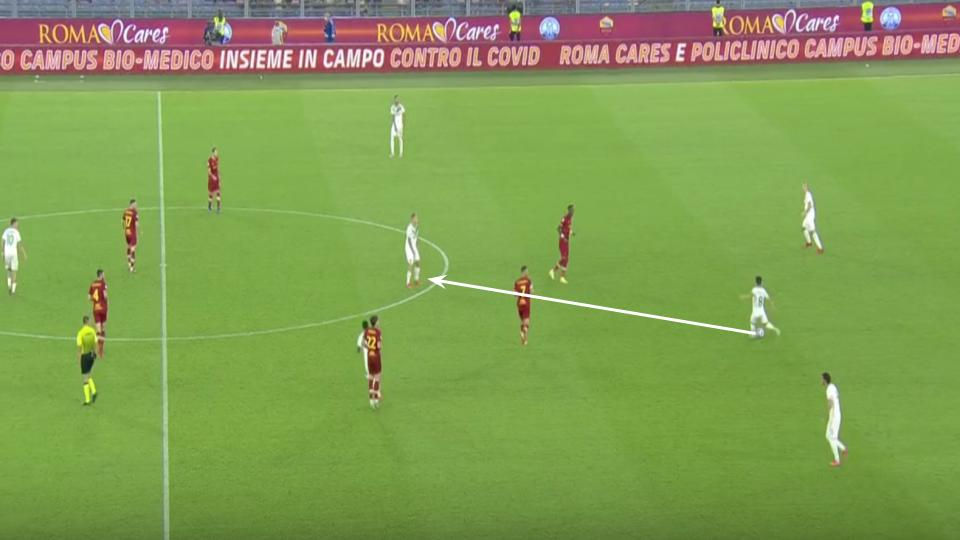
Sassuolo look to progress the ball forward as soon as possible, as Lopez did here.
The young Italian immediately turned and continued the move by breaking Roma’s second line when he freed Boga to run at the Roma defence, as illustrated below.
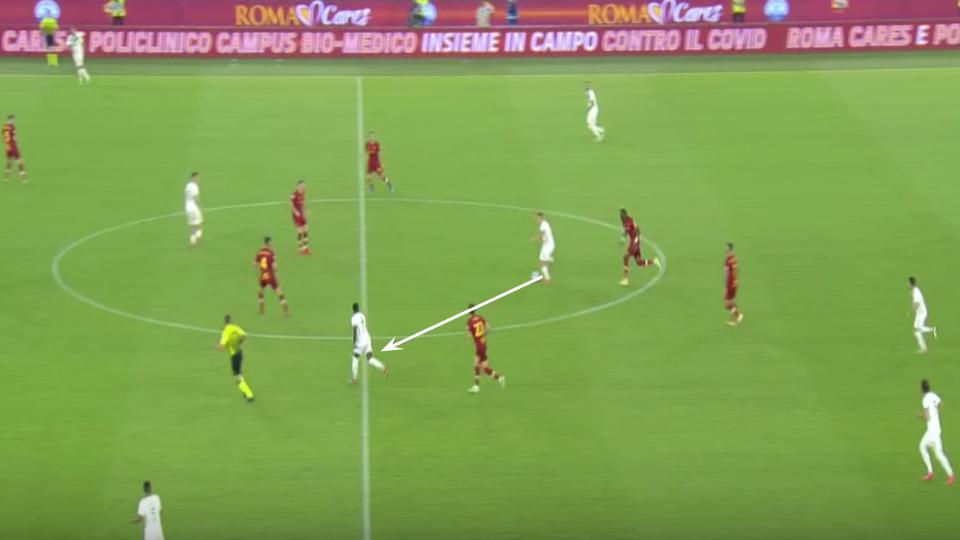
Frattesi then also opted to play forward.
Sassuolo seemingly look for the furthest pass forward that can be played with control. In the image below, Chiricheș took advantage of this by bypassing Roma’s midfield by playing the ball to Raspadori who combined with Toljan to set up a chance for Berardi. This image is actually a good example of how Sassuolo draw opponents out of possession and then attack the vacated space, as Veretout follows Đuričić away from the centre.
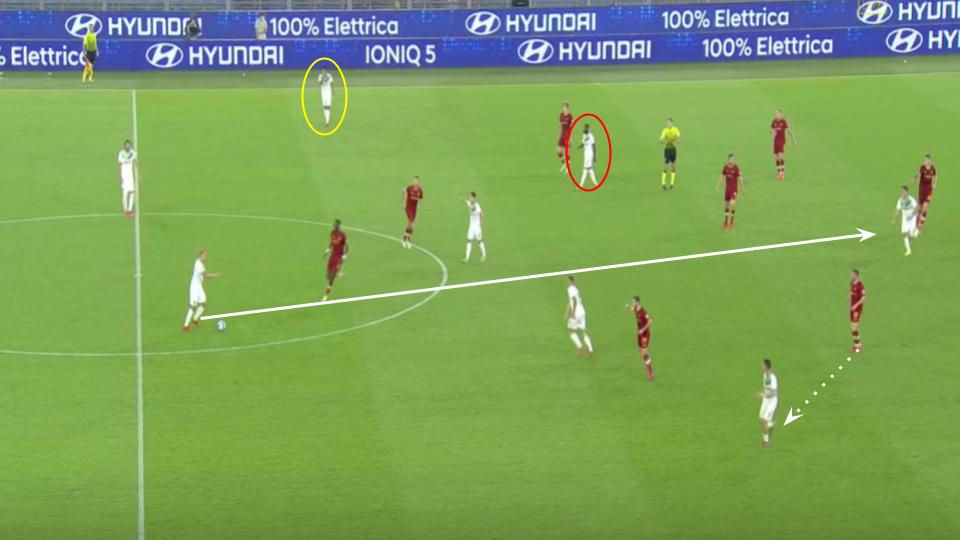
Additionally, notice the flexibility of Boga (red) and Rogerio (yellow) again.
The image below highlights this vertical focus again. Here, Frattesi has moved high and Rogerio has moved centrally next to Lopez. Upon receiving the ball, the Brazilian immediately looks for Raspadori’s run into depth.

Raspadori’s run occupies Gianluca Mancini so Rogerio could also have opted for Đuričić between the lines.
This principle of being as vertical as possible was evident in an idea that seemed to be game-specific.
Game-specific idea: Attacking space between centre-back and full-back
It seemed obvious that Dionisi wanted to target the space between centre-back and full-back on each side of the Roma defence. It wouldn’t be surprising that Dionisi had spotted the Roma full-backs’ willingness to play tight on their respective wingers and the centre-backs’ hesitancy to close the resulting space. Sassuolo targeted these spaces throughout the match.
In the image below, we can see one example of how this was done. Berardi was almost always wide and Roma’s left back Matias Viña was always eager to get tight to him. As a result, when the ball was on its way to Berardi, Toljan would attack the space between Viña and left-sided centre-back Roger Ibañez with an underlapping run. Berardi would often look to hit that space with a first time ball round the corner.

Berardi looked to draw Viña out of position for Toljan to attack that space.
On the opposite side, Rick Karsdorp was similarly aggressive in looking to close down Boga.We can see this in image below as Ferrari is on the ball. The space between Karsdorp and Mancini is huge and Rogerio, positioned centrally, attacks that space with a run into depth. Ferrari opened up an angle to play into Boga, drawing Karsdorp out, before firing the ball into the vacated space for Rogerio.
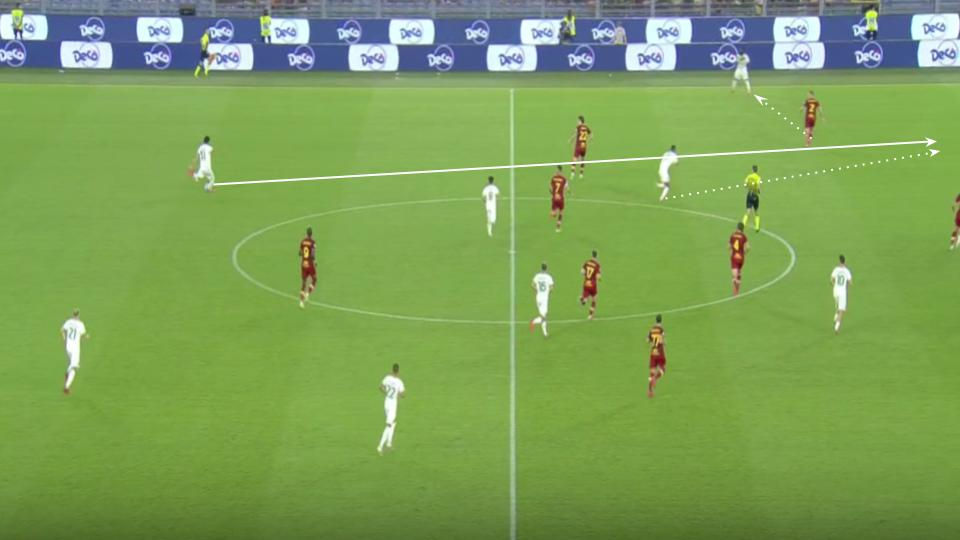
Boga drawing Karsdorp wide, opening up space to attack between the Dutchman and Mancini.
The image below highlights how large the spaces between full-back and centre-back was on each side, especially if you look at the minimal space between the two centre-backs. Here, Chiriches tried to find Đuričić over the top as the Serbian identified the space between Karsdorp and Mancini.
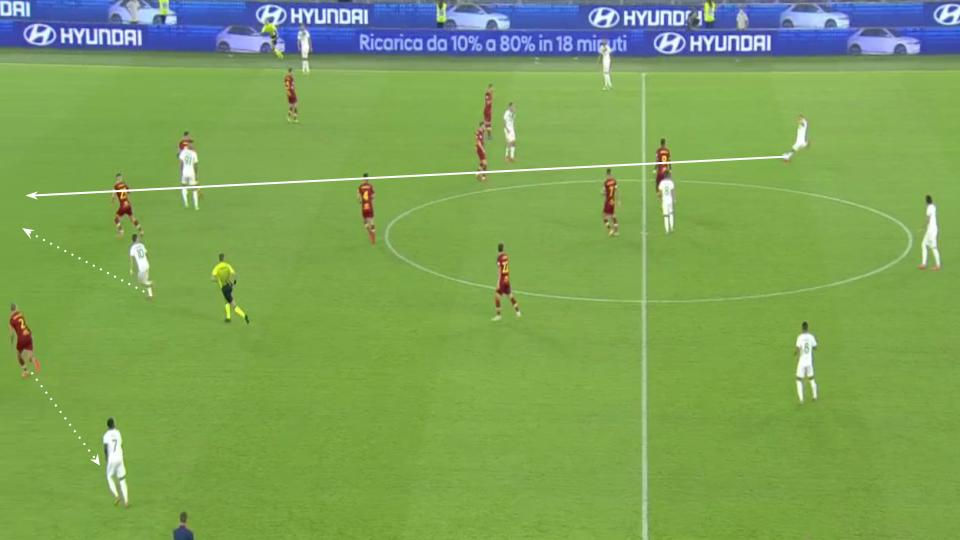
Karsdorp caught out here by going so close to Boga, which Đuričić tried to exploit with a blindside run behind Mancini.
Interestingly, Sassuolo also manipulated the Roma full-backs to isolate their wingers wide. This normally happened when Roma were in a more settled defensive shape deeper in their own half. Below, Raspadori has played a pass into Toljan whose central position has drawn Viña (red) inside. A quick combination between the two sets up a chance for Berardi but the finish was weak on this occasion.
In the image below, Viña is again attracted to the dummy run of Đuričić which opens up space for Berardi. The Italian scored this chance, but a marginal offside in the build up ruled the goal out.
In a similar scene to these last two, Sassuolo equalised when the substitute Gianluca Scamacca spotted Berardi in space after a Đuričić run similar to the example above had drawn Viña inside. On that occasion, Berardi’s low cross was turned in by the Serbian.
Conclusion
Alessio Dionisi’s Sassuolo have started the season really well and will feel disappointed not to leave Rome with at least a point. However, their performance illustrated why they should feel excited and confident going into the remaining 35 games as they highlighted an ability to perform really well at a tough venue due to their quality in deep build-up, understanding of space and positioning, verticality and their ability to identify weaknesses in the opponent’s defensive structure and then go on to exploit those weaknesses.
Despite Roberto De Zerbi and European champion Manuel Locatelli leaving in the summer, Sassuolo look likely to enjoy another exciting season under the guidance of a promising young coach.
Commentaires